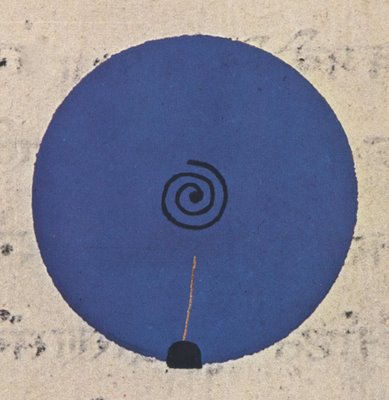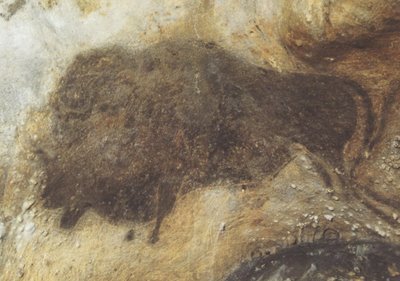Let's start by acknowledging that abstract art is outside the scope of this blog and outside the scope of my competence. However, I do like some abstract art. If you're willing to take a stroll with an uneducated man into a complex field, we may discover some interesting things together.
In my view, much of today's fine art scene is self-indulgent nonsense. The Museum of Modern Art in New York contains some great works of art, but the ratio of money to talent there is downright asphyxiating. Dollar for dollar, the art at the Society of Illustrators a few blocks away has more nutritional content. But there is no clear dividing line between art that illustrates a message or idea on the one hand and abstract art on the other. Here are some splendid illustrations that are not very different from the abstract paintings in my last posting:

Illustration of the descent of the divine power through a the symbolic fish-incarnation (from a 17th century Yogic manuscript).

Illustration of the evolution and dissolution of cosmic form from a 19th century Rajasthan book.

Vase painting from Athens in the 5th century BC

Cave painting circa 17,000 years ago.
Clearly, abstract art is no modern invention. It began when art began-- in the upper paleolithic period (from 35,000 to 12,000 years ago). More artistic and technological progress took place in those 25,000 years than in the previous 2 million years combined. That era saw the first explosion of symbolic (abstract) thinking and the accompanying birth of art. The designs and heavily stylized drawings scratched in the walls of ancient caves share a lot in common with today's abstract art. But unlike modern abstract art, which often seems detached and irrelevant, paleolithic art was close to the core of what it meant to be human. It was life-or-death relevant.
I have always liked Anthony Burgess' characterization:
Art is rare and sacred and hard work and there ought to be a wall of fire around it.
Abstract and conceptual art, when it is good, can satisfy that high standard. And since I've blabbered on too long today, I'll offer some thoughts next time on what "good" means to me in abstract art.

8 comments:
Good abstract art is usually about pure form, be it colour, line, shape. I also find good abstract art to project an emotion or an idea or philosophy of some sort that the artist is trying to express. I am not sure I really buy this concept that you forward, that incompetence hides easily in contemporary and modern art. There is just as much bad commercial art out there as fine art, plus a lovely drawing that promotes a commercial product doesn't really have more merit to me than a Rothko or a Gerhard Richter abstract painting simply because it is executed in a "realist" manner. Commercial art and "fine art" are two different animals who happen to share some of the same characteristics.
I'm not often moved by abstract art. I usually find "realist", or at least representative, art more interesting.
But, I have been moved a couple of times by abstract art. The investigation of pure form can be interesting, even moving. Personally, though, I find that investigations of pure form tend to be simplistic, for my tastes, or if they are complex, they end up looking random. Realistic works are more often close to my ideal of interesting complexity without losing coherence.
Anonymous, you have put your finger on at least one of the dilemmas in this area-- you say that good abstract art is about "pure form" but then you go on to say it also is about content ("an emotion or an idea or a philosphy.") Once art conveys a message (and it is hard to avoid one) then you have already stepped onto the slippery slope to illustration.
None of this stuff fits into tidy categories, but I do think it is indisputable that incompetence hides more easily in abstract or non-representational art. Modern "fine" art can include random mistakes, art created by monkeys or by tying a paintbrush to a donkey's tail, found objects, etc. It does not necessarily require technical skill, so it does not matter when that skill is lacking. There is a lot of bad representational art out there, but it is easier to identify because you have objective criteria by which to measure it.
I am also not so sure that "message" art is illustration. I tend to think of illustration to be visual art commissioned for the purpose of selling a product or an idea whereas many of the abstractionist pioneers were really creating something nobody really wanted. Malevich was really just challenging perception when he created his one colour paintings. The purpose of this kind of work was completely different from the concerns of modern commercial illustration and when I say modern I include the early twentieth century up till now, therefore I find comparing what N.C. Wyeth was doing to Mark Rothko or Ross Bleckner to be completely impossible. An illustration teacher that I knew stated to me that fine art in the modern sense is artist driven whereas illustration is often problem driven, the illustrator is trying to find the right answer to the client's desires.
The car illustrations that you posted are technically excellent but they were not created to ponder over, they were created to sell cars. The artist may have wrestled over how to accomplish them but they were not meant to be objects unto themself.
Don't get me wrong, I love illustration, I just have divided the concerns of illustiration and fine art. They are both valid art forms but both have separate criteria, to my mind anyway.
Anonymous, there is certainly more than one definition of "illustration" floating around out there, but by anyone's definition, Michelangelo, Rembrandt and Leonardo Da Vinci "illustrated" the Bible. Check out the ceiling of the Sistine Chapel for some great illustrations.
You may think that some of today's illustrations convey a more crass commercial text, but from Michelangelo to the latest advertisement for acne cream, illustrators use images to decorate, explain or heighten a message of some kind. This is contrasted with art for art's sake (which as you say is usually about pure form).
I think the distinction between illustration and "art for art's sake" is a better distinction than your distinction between illustration and "fine art." Raphael and Leonardo were undisputably fine artists, but they were constantly seeking patrons and commissions and were trying, as you put it, to "find the right answer to the client's desire." You can bet their portraits and altar pieces reflected their sponsor's wishes. What we think of today as "fine art" distinct from illustration is a relatively recent mutation in the nature of fine art. Sometimes I think it comes from a society with too much time and wealth on its hands.
I agree with the general opinions here about abstract art but there are always exceptions to the rule.
I recently discovered a guy from Canada who is doing amazing things along the lines of abstraction.
The name is Marti Garaughty, his website is http://www.garaughty.com
In general most of what I see from abstract artists is pathetic but I've also seen a few very good ones. I have another painter I like but I can't find the link so I'll post it when I can find it.
I tend to think of illustration as being commissioned from a client for either books, editiorial magazine articles, advertising, package design, comics etc. Anything with commercial intent. I don't think it is a crass form of art, I just think it's priorities are different and has to be judged on separate criteria because the intent at the onset of it's creation is completely different from "fine art". I don't think that Renaissance artist's were illustrators even though they often depicted religious scenes. Yes, they had clients but an artist has to have clients to make a living, Leonardo was a painter (15 known works) but he was many other things as well for his employers. Think of what happens when you put a Caravaggio on the cover of a novel, it is usually accompanied by text and the viewer may feel that it is tied into the narrative inside the book, what you have is a re-contextualizing (is that a word?) of the painting. The Caravaggio ends up being confused and not (in my mind) being taken for it's what it truthfully is supposed to be for.
Do we have too much time and wealth on our hands? Some of us clearly do. I agree with you that it is ridiculous to pay $140 million for a painting (that money could buy an awful lot of original comic pages, or help save the environment) but if somebody wants to buy a Picasso for that much then it's their business. Is there a lack of quality in abstract art these days? In a lot of cases I'm sure there is but there are others out there creating very beautiful work and they do care about it. I think there is a general lack of quality in a lot of things these days.
I'm beginning to wonder if time has the affect of separating the image from it's crass associations, so that if/when our society is divorced from the ugliness of profiteering we will look at these amazing works like Leyendecker's and appreciate them for their beauty, although caricature seems by definition to be a kind of vulgarity, and I say that as one who loves caricatures.
Post a Comment